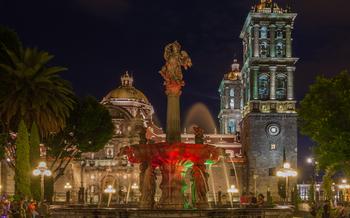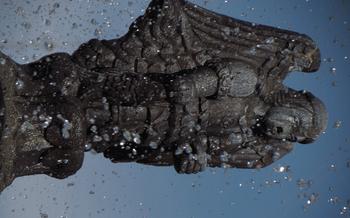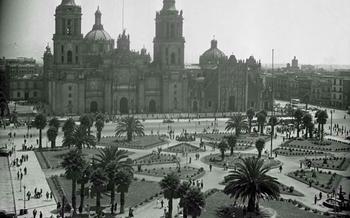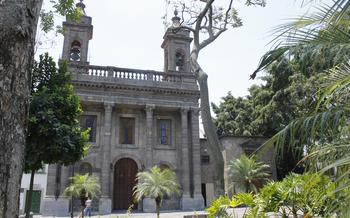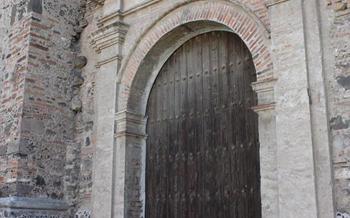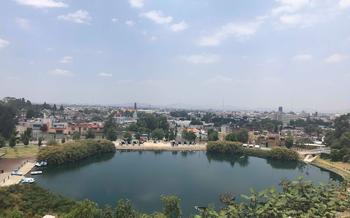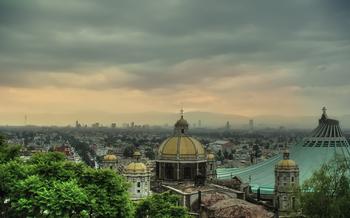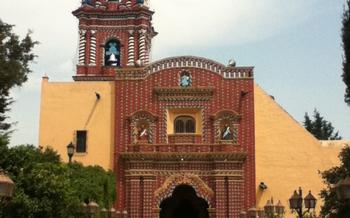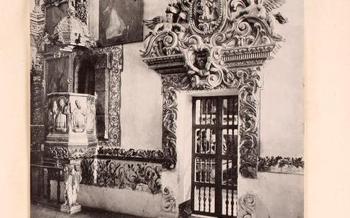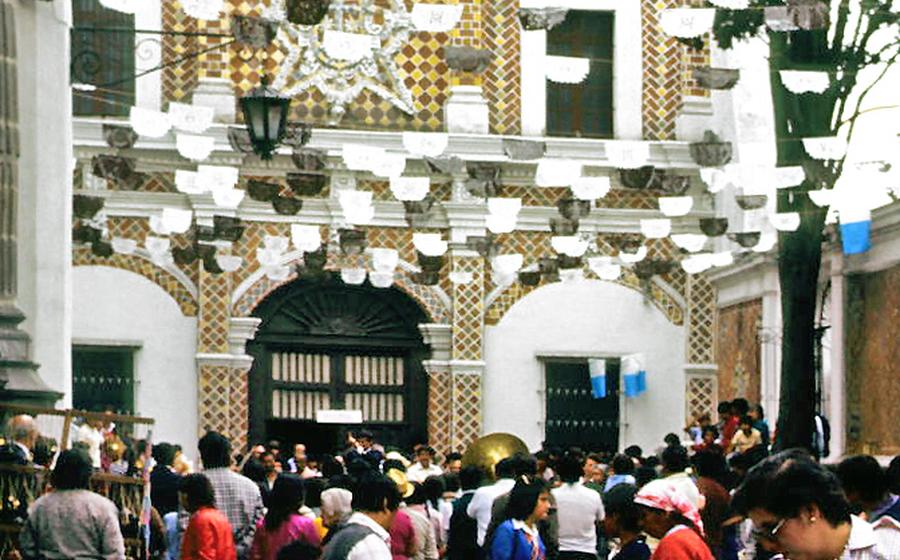
Iglesia de Nuestra Señora del Carmen
- Historical Significance
- Location and Accessibility
- Exploring the Interior
- Exterior Architecture and Features
- Religious Significance
- History and Cultural Impact
- Local Legends and Folklore
- Views and Photo Opportunities
- Nearby Attractions
- Local Cuisine and Gastronomy
- Pilgrimages and Religious Events
- Accessibility for All
- Sustainable Travel Tips
- Insider Tip: Hidden Gem
Historical Significance
The Iglesia de Nuestra Señora del Carmen, nestled in and devotion to religious expression. Its construction dates back to the 16th century when the Carmelite Order, driven by their faith and a desire to spread Catholicism, embarked on a mission to build a church dedicated to Our Lady of Mount Carmel. The church's design was entrusted to the skilled hands of Francisco Becerra, a renowned architect who masterfully blended Renaissance and Baroque elements, creating a harmonious architectural masterpiece. Over the centuries, the church has undergone several renovations and expansions, each leaving its unique mark on the structure, while preserving its original essence and historical significance. Today, the Iglesia de Nuestra Señora del Carmen stands as a symbol of Puebla's enduring faith, its architectural heritage, and the city's devotion to the Virgin Mary.
Location and Accessibility
The Iglesia de Nuestra Señora del Carmen is situated, a mere two blocks from the city's iconic Zócalo. Its prime location makes it easily accessible on foot or by public transportation.
For those arriving by car, limited street parking is available in the surrounding area. However, visitors are advised to utilize nearby parking garages or lots for a more convenient and secure option.
Public transportation offers a convenient alternative to reach the church. Multiple bus routes stop within a short walking distance, and the city's efficient metro system provides easy access from various parts of Puebla. The closest metro station, Zócalo, is just a few minutes' walk from the church.
Exploring the Interior
The interior of the Iglesia de Nuestra Señora del Carmen is a testament to the artistic and spiritual grandeur of the church. The main altar, crafted from intricate woodwork and adorned with gold leaf, is a breathtaking sight. Its central focus is a striking depiction of Our Lady of Mount Carmel, the church's patron saint. The altar is surrounded by elaborate carvings, sculptures, and paintings that tell stories of biblical events and the lives of the saints.
As you wander through the church, take time to admire the numerous paintings and sculptures that grace its walls. These artworks, many of which date back to the 17th and 18th centuries, showcase the exceptional talent of local artisans and offer a glimpse into the religious and cultural history of Puebla.
One unique feature of the church's interior is its collection of ex-votos, or folk art offerings. These small paintings, often depicting scenes of miracles or gratitude, are left by worshippers as a testament to their faith and the power of prayer. They offer a fascinating glimpse into the personal devotions and beliefs of the local community.
Exterior Architecture and Features
The facade of the Iglesia de Nuestra Señora del Carmen is a captivating blend of Baroque and Neoclassical styles. Its intricate carvings and sculptures narrate biblical stories and depict saints and angels. The main entrance, adorned with an arched lintel, invites you into the church's sacred space.
The bell tower, a prominent feature of the church, stands tall and majestic. Its harmonious proportions and detailed ornamentation make it a masterpiece of architectural craftsmanship. The tower houses a set of melodious bells that chime throughout the day, adding to the spiritual ambiance of the neighborhood.
Surrounding the church is a charming plaza that serves as a gathering place for locals and visitors alike. This open space, shaded by mature trees, offers a serene oasis amidst the bustling city. Benches and fountains adorn the plaza, providing a tranquil spot to relax and reflect after exploring the church's interior.
Religious Significance
The Iglesia de Nuestra Señora del Carmen holds immense religious significance for the people of Puebla and beyond. It is dedicated to Our Lady of Mount Carmel, a revered figure in the Catholic faith. The church serves as a spiritual center for devotees who come to pray, offer their thanksgivings, and seek solace. It is believed that the Virgin Mary, under the title of Our Lady of Mount Carmel, appeared to a Carmelite monk, St. Simon Stock, in the 13th century, promising her protection and blessings to those who wear the brown scapular. This sacred tradition is associated with the Iglesia de Nuestra Señora del Carmen, attracting pilgrims and believers from all corners of the region. The church celebrates the feast of Our Lady of Mount Carmel annually on July 16, marked by grand processions, masses, and festivities that draw thousands of faithful worshippers. The church also plays an essential role in local religious practices, hosting regular services, confessions, and special events throughout the year, fostering a deep connection between the community and their cherished faith.
History and Cultural Impact
The Iglesia de Nuestra Señora del Carmen holds a significantth century, it has witnessed numerous historical events and contributed to the city's religious and cultural tapestry. Over the centuries, the church has undergone several renovations and expansions, reflecting the changing artistic styles and tastes of the era. Its enduring presence has made it a revered landmark, deeply embedded in the collective memory of Puebla's people.
The church has played a pivotal role in shaping the religious practices and traditions of the city. As a center of devotion to the Virgin of Carmen, it attracts pilgrims and worshippers from near and far. The annual feast day of the Virgin, celebrated on July 16th, is a grand occasion marked by colorful processions, traditional dances, and fervent prayers. These festivities not only showcase the church's religious significance but also serve as a testament to the enduring faith and devotion of the local community.
Beyond its religious significance, the Iglesia de Nuestra Señora del Carmen has had a profound impact on Puebla's cultural heritage. Its architectural grandeur, intricate artwork, and historical artifacts have inspired artists, writers, and musicians alike. The church has served as a backdrop for numerous cultural events, including concerts, art exhibitions, and theatrical performances. Its presence has fostered a vibrant cultural scene in the city, contributing to its reputation as a cultural hub of Mexico.
Local Legends and Folklore
The Iglesia de Nuestra Señora del Carmen is steeped in local legends and folklore that add to its mystique. According to one popular tale, the church was built on the site of an ancient indigenous temple dedicated to the goddess Chalchiuhtlicue, the Aztec deity of water. It is believed that the church's patron saint, Our Lady of Mount Carmel, replaced Chalchiuhtlicue as the protector of the local community, symbolizing the blending of indigenous and Catholic beliefs.
Another legend tells the story of a young woman named Carmen who was miraculously cured of a terminal illness after praying to Our Lady of Mount Carmel. In gratitude, she dedicated her life to serving the church and became a beloved figure in the community. Her spirit is said to reside in the church, watching over the faithful and granting their prayers.
These legends and stories have been passed down through generations, weaving a tapestry of faith, history, and cultural traditions. They add a unique dimension to the church, making it not just a religious site but also a place where the past and present intertwine.
Views and Photo Opportunities
Iglesia de Nuestra Señora del Carmen offers captivating views and ample opportunities to capture stunning photographs. As you step outside the church, you'll be greeted by a picturesque plaza that provides a panoramic vista of the church's majestic facade. With its intricate details and towering spires reaching towards the sky, the church presents an awe-inspiring sight.
For the best photo opportunities, position yourself in the center of the plaza to capture the church's full grandeur. Take advantage of the golden hour, just before sunset, when the warm light casts a magical glow on the church's exterior. Experiment with different angles and perspectives to create unique and captivating shots.
If you're an early riser, don't miss the opportunity to witness the sunrise over the church. The soft hues of pink, orange, and yellow create a serene and ethereal atmosphere, transforming the church into a breathtaking spectacle.
Once inside the church, look for unique vantage points to capture the intricate details of the interior. The main altar, with its ornate carvings and shimmering gold leaf, is a focal point that demands attention. The intricate paintings and sculptures that adorn the walls and ceiling offer endless opportunities for creative photography.
Remember to be respectful of the sanctity of the church while taking photographs. Avoid using flash or tripods that might disturb other visitors or disrupt religious services. With a little patience and creativity, you'll capture stunning images that will forever immortalize your visit to this architectural masterpiece.
Nearby Attractions
The Iglesia de Nuestra Señora del Carmen stands as a remarkable testament to Puebla's rich heritage, surrounded by an array of captivating attractions that beckon visitors to explore further. Just a short stroll away, the majestic Catedral de Puebla, with its soaring spires and intricate facade, invites you to delve into its sacred history and architectural wonders.
For those seeking artistic inspiration, the Museo Amparo, nestled nearby, showcases a treasure trove of pre-Hispanic artifacts, colonial masterpieces, and contemporary art, offering a glimpse into Mexico's diverse cultural tapestry. Alternatively, the Biblioteca Palafoxiana, a UNESCO World Heritage Site, houses a collection of rare books and manuscripts that will captivate history and literature enthusiasts alike.
Strolling along the charming streets of Puebla, visitors will stumble upon hidden gems such as the Museo del Juguete Antiguo México (Antique Toy Museum), a delightful haven for those young and old, showcasing a whimsical collection of vintage toys from around the world. For a taste of local flavors, the Mercado El Parián, a traditional market, offers an array of culinary delights, from traditional Mexican dishes to handcrafted souvenirs.
Whether you seek spiritual enlightenment, cultural immersion, or culinary adventures, Puebla's vibrant tapestry of attractions, woven around the Iglesia de Nuestra Señora del Carmen, promises an unforgettable journey that will linger in your memories.
Local Cuisine and Gastronomy
Puebla's culinary heritage is a fusion of indigenous and Spanish flavors, resulting in a distinct and delectable cuisine. When visiting the Iglesia de Nuestra Señora del Carmen, don't miss the opportunity to indulge in local delicacies.
Stroll through the streets surrounding the church and discover traditional restaurants and eateries, each offering a taste of Puebla's gastronomic treasures. Sample the iconic Mole Poblano, a complex and flavorful sauce made with over 20 ingredients, often served with chicken or turkey.
Chiles en Nogada is another must-try dish, featuring poblano peppers stuffed with a mixture of picadillo, fruits, and nuts, topped with a creamy walnut sauce and pomegranate seeds. It's a feast for both the eyes and the palate, representing the colors of the Mexican flag.
For a quick and satisfying snack, try Cemitas, a type of sandwich made with sesame-seed bread, filled with various ingredients like shredded chicken, avocado, cheese, and papalo leaves.
For dessert, treat yourself to Camotes, candied sweet potatoes, or Tortitas de Santa Clara, delicate almond cookies filled with a sweet pumpkin paste.
Insider Tip: Ask locals for recommendations on local markets or street food stalls, where you can find authentic and affordable Puebla flavors.
Pilgrimages and Religious Events
The Iglesia de Nuestra Señora del Carmen holds a profound significance as a pilgrimage site for devotees of various saints and religious figures associated with the church. Throughout the year, the church welcomes pilgrims and visitors who seek spiritual fulfillment and divine intervention. Notable religious events and festivals are held within the church premises, attracting a multitude of believers and creating a vibrant atmosphere of devotion.
One of the most significant events celebrated in the church is the feast of Our Lady of Mount Carmel, the church's patron saint. This grand celebration takes place annually on July 16th and is marked by elaborate processions, masses, and festivities honoring the Virgin Mary. Pilgrims from across the region and beyond flock to the church to pay homage to Our Lady of Mount Carmel and seek her blessings.
During these religious events, the church is adorned with colorful decorations, flowers, and intricate altarpieces, creating a captivating spectacle that reflects the deep faith and devotion of the local community. The air is filled with the sounds of prayers, hymns, and traditional music, adding to the spiritual ambiance of these sacred gatherings.
Accessibility for All
The Iglesia de Nuestra Señora del Carmen is committed to providing an inclusive and welcoming environment for visitors of all abilities. Wheelchair users and individuals with disabilities can easily access the church through designated ramps and elevators, ensuring a seamless and comfortable experience. Inside the church, spacious aisles allow for smooth movement, and accessible seating areas are available for those who need them. Audio guides and guided tours in multiple languages, including sign language interpretation, are provided to cater to the diverse needs of visitors. Additionally, accessible restrooms are available within the church premises, ensuring convenience and comfort for all. By prioritizing accessibility, the Iglesia de Nuestra Señora del Carmen strives to create a welcoming and inclusive space for everyone to enjoy and appreciate the beauty and history of this sacred place.
Sustainable Travel Tips
When exploring the Iglesia de Nuestra Señora del Carmen, consider adopting sustainable travel practices to minimize your environmental impact. Opt for eco-friendly transportation options, such as walking, cycling, or using public transportation, to reduce carbon emissions. Show respect for the church's cultural and religious significance by dressing modestly and adhering to any specific guidelines or customs. Embrace responsible tourism by supporting local businesses that prioritize sustainability, such as restaurants using locally sourced ingredients or shops selling handmade crafts. These conscious choices contribute to preserving the church's unique heritage while promoting a positive impact on the community.
Insider Tip: Hidden Gem
Beyond its grand facade and ornate interior, the Iglesia de Nuestra Señora del Carmen holds a hidden gem that often goes unnoticed by visitors. Tucked away in a secluded corner of the church, you'll find a small, unassuming door that leads to a hidden staircase. As you ascend the narrow steps, a sense of anticipation builds, leading you to a secret rooftop terrace.
Emerging onto the terrace, you'll be greeted by a breathtaking panoramic view of Puebla. The city's red-tiled roofs, vibrant plazas, and towering spires stretch out before you, creating a mesmerizing tapestry of color and texture. This hidden vantage point offers a unique perspective, allowing you to appreciate the grandeur of the church's architecture and the beauty of the surrounding cityscape.
As you stand there, enveloped in the tranquility of the hidden terrace, you'll feel a sense of awe and wonder. It's a moment to savor, a chance to connect with the history and spirit of this sacred place in a truly unforgettable way.
